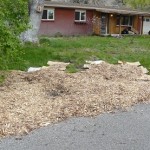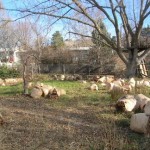The Problem with Lawn
The least natural landscape element in the arid West–a Kentucky bluegrass lawn–requires huge inputs of water, fertilizers, herbicides and labor to keep it looking neat and tidy. Lawns are necessary for some purposes, like soccer and golf, but in many urban landscapes they serve no functional purpose at all. Where turf is useful, e.g., kids and pets, low water grass alternatives are now available: buffalo grass, blue gramma and others. Otherwise, it makes sense to replace lawns with more interesting and less labor-intensive (no mowing!) perennial gardens.
Getting Rid of Lawn
There are basically three methods. 1. Quick but not easy: Rent a sodbuster and dig it out. 2. Slower, but easy and neat: Smother in the fall with a good layer of newspaper or cardboard and 8” of fall leaves. Plant into the ready-made mulch. 3. Slower still, and potentially ugly and weedy: don’t water for two or three years. Here are some smothering ideas:



Advantages of native plants
Plants native to our region are already adapted to low rainfall, summer heat and, in many cases, poor soils. They can survive with fewer resources and less labor! Gardens that feature native plants encourage populations of native birds and insects; the garden can become an ecosystem existing in harmony with the surrounding countryside. Learning to recognize native plants is fun and educational!
High-performance non-natives
A huge array of non-native perennials are available to complement natives in a water-thrifty landscape. The increasing interest in water-conserving landscapes has resulted in the introduction of many beautiful new (to us) species from other arid climates, mainly the Mediterranean, Western Asia, and South Africa. As growers, we at Draggin’ Wing Farm are always careful to avoid overly aggressive non-natives that may escape and become problem weeds in natural areas.
Planting and maintenance
The best times of year to plant are spring and fall. The advantage of fall planting is that plants have the chance to get their root systems established over winter and are ready to take off in the spring. The downside is that some perennials may not survive that first winter, depending on the severity of the weather.
All perennials need at least one year to really develop a good root system and become established. They will need more regular moisture during this establishment period and become truly drought-tolerant in their second or third years.
Weeding
Important! This can’t be emphasized enough. Staying on top of first-year weeds is well worth the effort, for weed problems will be greatly reduced in subsequent years because:
- you won’t be turning over soil and bringing weed seeds to the surface
- you won’t allow any first-year weeds to go to seed
your perennial plants will grow and crowd out or shade out potential weeds
Mulching
Mulching greatly helps in reducing weed problems. Try bark, fall leaves, gravel, lava fines or straw. Mulch also tends to conserve moisture in the soil, and that is a good thing as long as you have well-drained soil. If you have lots of clay in your soil, be careful of mulches that will keep soil wet all winter long and potentially rot the roots of your drought-tolerant perennials. One cubic yard of mulch will cover 100 square feet of landscape 3- 4” deep.
Watering
Newly planted perennials need to be watered in and irrigated regularly until established–unless you plant very late in the fall. Some drought-tolerant plants will survive in our climate on no additional water, but almost all will grow faster and bloom longer with some supplemental irrigation.
A typical xeriscape in Southern Idaho will do well if watered weekly in the heat of July and August and once every two to four weeks in June and September.
The most water-efficient approach is drip irrigation. Existing sprinkler systems can be retrofitted to drip, and drip systems can incorporate sprinklers or mini-sprinklers in some areas.
Pruning
Many perennials benefit from pruning after initial bloom to encourage re-bloom in late winter or early spring to remove dead top growth and make way for new foliage. Letting brown stems and leaves stand all winter long adds structure and interest to the winter landscape and provides habitat for over-wintering birds.
Division
Many–but not all–perennials can be divided after three or four years, usually in early spring. This can help if the center has died out of an older plant or it has begun to lose vigor. You can also divide simply to increase your plantings or share with friends. Ask us if you wonder about particular plants.
Moving Plants Around
Don’t be afraid to dig up and move smaller perennials (but not large shrubs and trees) to new spots in the garden. It’s best done in the spring or fall, when the weather is not hot and plants are not actively growing. Allow your landscape to change and evolve over time as you observe what does well where and what composition of plants provides structure and beauty year-round.
